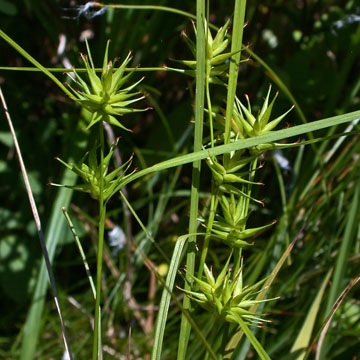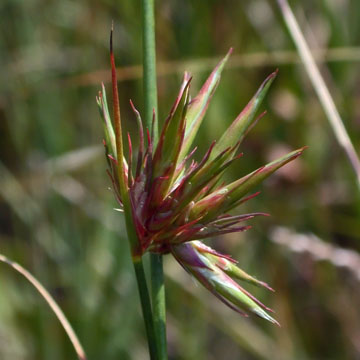

Carex michauxiana - (image 1 of 2)
Taxonomy
Family: Cyperaceae
Section Rostrales
Habitat
Wet meadows, bogs.
Associates
Distribution
Newfoundland to Ontario, northern MI, northeast MN, and Saskatchewan, south to NY.
Morphology
Tufted perennial, 20-60 cm; main leaves 1.5-4 mm wide; terminal spike staminate, to 1.5 cm, sessile or nearly so, barely projecting beyond the upper pistillate ones; pistillate spikes 2-4, broadly ovoid, erect, the lower peduncled, the upper less so; bracts leaf-like, 1-3 mm wide, surpassing the stem, their sheaths concave at the apex; pistillate scales ovate, a third to half as long as the perigynia, hyaline or brown-tinged with a green midstrip, acute or acuminate; perigynia slenderly subulate, 8-13 mm long, nearly round in cross-section, many-nerved, long-attenuate into a slender beak with erect teeth 1 mm long; achene loosely enclosed in the perigynia, rounded-trigonous, continuous with the persistent style.
Notes
Fruiting June to July.
Wetland indicator: OBL
The spikes of C. folliculata are similar in appearance but borne on longer peduncles. It also has wider leaves (4-16 mm) and bracts-sheaths that are prolonged at the apex (vs. concave at the apex). Psyllid larvae can sometimes cause galls on Juncus spp. (shown below) that look superficially like the spikes of C. michauxiana.

References
Gleason, Henry A. and A. Cronquist. 1991. Manual of Vascular Plants of
Northeastern United States and Adjacent Canada. Second Ed.
The New York Botanical Garden. Bronx, NY
|
© Michael Hough 2018 |